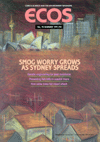Effects of photochemical smog
The main constituents of photochemical smog are ozone and nitrogen dioxide. Although ozone is widely considered the chief indicator of photochemical smog, nitrogen dioxide is an important pollutant in its own right, affecting human and plant health and playing a role in the formation of acid rain. Ozone, a powerful oxidising gas, readily attacks living tissue. In humans it can cause sore throats, inflammation and discharges in the nasal passages. Ozone also attacks plants during the growing season at low concentrations, especially citrus fruits, potatoes, legumes and soyabeans, affecting their ability to photosynthesise. Combined with other compounds in photochemical smog, the gas damages buildings and degrades rubber, clothing and paint dyes, resulting in substantial economic costs.



